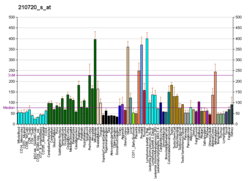APBA2BP
N-terminal EF-hand calcium-binding protein 3 is a protein that in humans is encoded by the NECAB3 gene.[5][6]
The protein encoded by this gene interacts with the amino-terminal domain of the neuron-specific X11-like protein (X11L), inhibits the association of X11L with amyloid precursor protein through a non-competitive mechanism, and abolishes the suppression of beta-amyloid production by X11L. This protein, together with X11L, may play an important role in the regulatory system of amyloid precursor protein metabolism and beta-amyloid generation. This gene consists of at least 13 exons and its alternative splicing generates at least 2 transcript variants.[6]
References
- 1 2 3 GRCh38: Ensembl release 89: ENSG00000125967 - Ensembl, May 2017
- 1 2 3 GRCm38: Ensembl release 89: ENSMUSG00000027489 - Ensembl, May 2017
- ↑ "Human PubMed Reference:".
- ↑ "Mouse PubMed Reference:".
- ↑ Lee DS, Tomita S, Kirino Y, Suzuki T (Aug 2000). "Regulation of X11L-dependent amyloid precursor protein metabolism by XB51, a novel X11L-binding protein". J Biol Chem. 275 (30): 23134–8. doi:10.1074/jbc.C000302200. PMID 10833507.
- 1 2 "Entrez Gene: APBA2BP amyloid beta (A4) precursor protein-binding, family A, member 2 binding protein".
External links
- Human NECAB3 genome location and NECAB3 gene details page in the UCSC Genome Browser.
Further reading
- Büssow K, Cahill D, Nietfeld W, et al. (1998). "A method for global protein expression and antibody screening on high-density filters of an arrayed cDNA library". Nucleic Acids Res. 26 (21): 5007–8. doi:10.1093/nar/26.21.5007. PMC 147919. PMID 9776767.
- Sugita S, Südhof TC (2000). "Specificity of Ca2+-dependent protein interactions mediated by the C2A domains of synaptotagmins". Biochemistry. 39 (11): 2940–9. doi:10.1021/bi9920984. PMID 10715114.
- Deloukas P, Matthews LH, Ashurst J, et al. (2002). "The DNA sequence and comparative analysis of human chromosome 20". Nature. 414 (6866): 865–71. doi:10.1038/414865a. PMID 11780052.
- Sugita S, Ho A, Südhof TC (2002). "NECABs: a family of neuronal Ca(2+)-binding proteins with an unusual domain structure and a restricted expression pattern". Neuroscience. 112 (1): 51–63. doi:10.1016/S0306-4522(02)00063-5. PMID 12044471.
- Strausberg RL, Feingold EA, Grouse LH, et al. (2003). "Generation and initial analysis of more than 15,000 full-length human and mouse cDNA sequences". Proc. Natl. Acad. Sci. U.S.A. 99 (26): 16899–903. doi:10.1073/pnas.242603899. PMC 139241. PMID 12477932.
- Sumioka A, Imoto S, Martins RN, et al. (2003). "XB51 isoforms mediate Alzheimer's beta-amyloid peptide production by X11L (X11-like protein)-dependent and -independent mechanisms". Biochem. J. 374 (Pt 1): 261–8. doi:10.1042/BJ20030489. PMC 1223589. PMID 12780348.
- Yoo JC, Chang JR, Kim SH, et al. (2004). "NIP1/XB51/NECAB3 is a potential substrate of Nek2, suggesting specific roles of Nek2 in Golgi". Exp. Cell Res. 292 (2): 393–402. doi:10.1016/j.yexcr.2003.09.025. PMID 14697346.
- Ota T, Suzuki Y, Nishikawa T, et al. (2004). "Complete sequencing and characterization of 21,243 full-length human cDNAs". Nat. Genet. 36 (1): 40–5. doi:10.1038/ng1285. PMID 14702039.
- Gerhard DS, Wagner L, Feingold EA, et al. (2004). "The status, quality, and expansion of the NIH full-length cDNA project: the Mammalian Gene Collection (MGC)". Genome Res. 14 (10B): 2121–7. doi:10.1101/gr.2596504. PMC 528928. PMID 15489334.
This article is issued from
Wikipedia.
The text is licensed under Creative Commons - Attribution - Sharealike.
Additional terms may apply for the media files.




